|
|
|
|
Products mentioned in this Article
--None--
|
|
|
|
|
|
|
|
|
 |
|
|
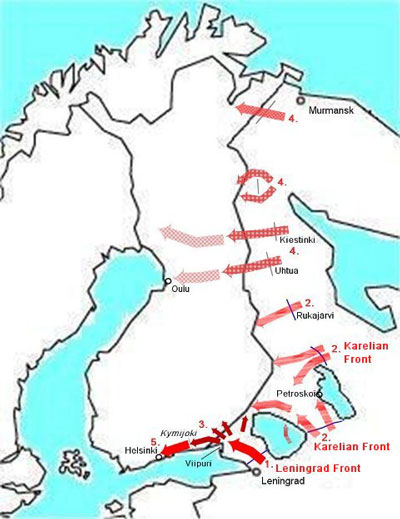 |
The Fourth Strategic Offensive
By Alessandro Fasolo
Towards the end of 1943 the Soviets began to plan their actions for the next year. The High Command’s plan was articulated in four major offensives: the First Strategic Offensive would start in January and take place in the Leningrad area with troops from the Leningrad Front and Volkhov Front; the Second Strategic Offensive would take place in the West Ukraine with the first and the second Ukrainian Front; in the Third Strategic Offensive the third and the fourth Ukrainian Front units would attack in the south; the target for the Fourth Strategic Offensive would be Finland.
Stalin’s plane for Finland called for a two-pronged assault, one from Leningrad through Vyborg to river Kymijoki and the second across the river Svir through Petrozavodsk and Sortavala to pass the 1940 border and to prepare an advance deep into Finland.
The Forces
Since 1941 the Finns had been building fortified defensive lines, and on the Karelian Isthmus there were three of them.
|
The first two were the so-called Main Line, which was constructed along the front line of 1941 and the VT-line (Vammelsuu-Taipale) running 20km behind the Main Line. These two were reinforced with numerous concrete fortifications, but the work was still on-going. The third line, the "VKT-line" (Viipuri-Kuparsaari-Taipale) was still at a design stage and its construction began in late May 1944 to the front of Vyborg. On the northern shore of the River Svir the Finns had prepared a deep area that was fortified with strong points with concrete pillboxes, barbed wire, obstacles and trenches. Behind the 1940 border there was also the Salpa Line with concrete bunkers before the River Kymijoki.
|
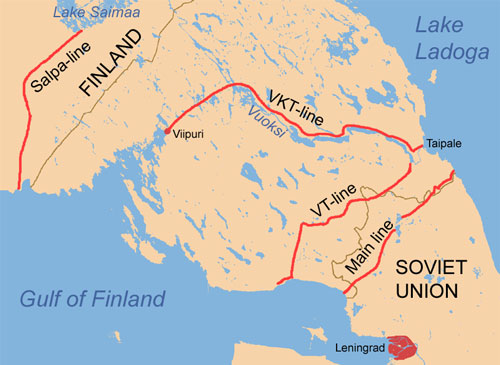 |
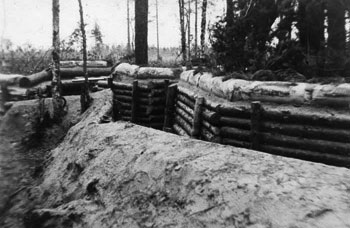 |
On Karelian Isthmus Finns had two Army Corps, the 3rd and the 4th, altogether about 90,000 men. The Aunus Group was at the river Svir between the lakes Laatokka and Ääninen (Onega) and also had the strength of around 90,000 men. Between Lake Ääninen and Lake Seesjärvi, on the Maaselkä isthmus, the 2nd Army Corps had 45,000 troops. The 14th Division was alone at Rukajärvi and in the rear of the German operational area. In total there where 268,000 Finns with 2,350 guns, 110 tanks/assault guns and 250 planes, 40% of the men and guns and all tanks on the Isthmus.
To overcome the defenders STAVKA gave to Leningrad Front 11 rifle divisions and 9 tank and assault-gun regiments.
|
|
At the end of the build-up in the Isthmus there were 19 divisions, 2 divisions’ strength in fortified areas, 14 tank/assault-gun regiments and over 220 artillery and rocket launchers battery groups (almost 3,000 guns/launchers). Around 1500 planes from the 13th Air Army and the Baltic Fleet Air Group also contributed to the attack with the Soviet Baltic fleet. To the East Karelia STAVKA sent 9 divisions, 2 Engineer-Sapper brigades, 2 tank brigades and 3 assault-gun regiments, bringing the whole force to 16 divisions, 2 divisions’ strength in fortified areas, 5 Engineer-Sapper brigades, 2 tank brigades, 3 assault-gun regiments and 3 tank battalions. They were supported by the Lake Ladoga (Laatokka) and the Lake Onega (Ääninen) naval detachments and the 7th Air Army.
Comparing forces, the Soviets had a 12:1 advantage in men and 3-5:1 advantage in guns, planes and tanks against the Finns.
|
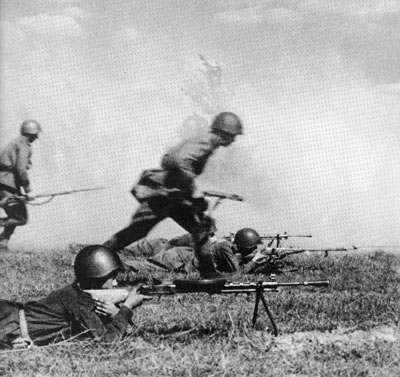 |
|
The Attack
The Leningrad Front started with heavy artillery fire followed by the first reconnaissance probes in the morning of 9 June 1944. The date was chosen in coordination with the Western Allies' landings in Normandy.
On the first day the assaulting Soviet units were able to take some Finnish strong-points in the front line near the Gulf of Finland. The main offensive started next morning, on 10 June, with an artillery barrage and led into immediate success. The frontline was breached at Valkeasaari and the defending Finnish troops abandoned their positions. The artillery barrage had lasted for over two hours and 3,000 guns and mortars taken part in it. On the focal point, where the 30th Guards Corps led the attack, the Soviets had more than 120 artillery pieces per kilometre.
|
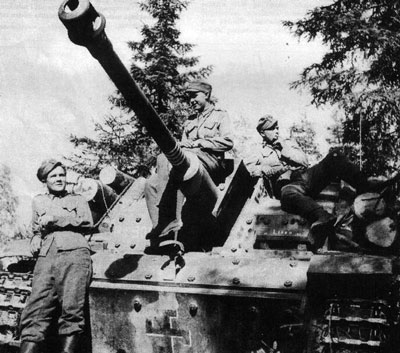 |
Four days later, on 14 June, the second Finnish defensive line, the VT
Line (Vammelsuu – Taipale) was penetrated at Kuuterselkä. The Finnish
Jaeger Brigade attempted to recover the VT Line, but it proved
impossible. In the counterattack, battle group Puroma (Jaeger Brigade,
less 5. Jaeger Battalion, and an Assault Gun Battalion) attacked
against Soviet 72nd Rifle Division, 185th Tank Regiment, 351st Assault
Gun Regiment, 46th Anti-tank Brigade and 119th Independent Anti-tank
Battalion. The attack went well at first, but was halted by murderous
Soviet fire. During the Finnish counterattack the Soviets lost 20-40
tanks, 27 guns and many men. Finnish casualties were also severe, 5
assault guns and over 600 men.
Soviet troops got through a breach to the rear of the Finnish Cavalry Regiment fighting in the Vammelsuu-Ino area. On the VT Line to the east of Kuuterselkä, in Siiranmäki, the Finnish 2nd Division fought against three Soviet divisions concentrated in a small area.
|
|
The battle started on 13 June and for fours days the Finns kept their position, until the events in Kuuterselkä and Mannerheim's decision forced them to leave the VT Line and withdraw to the third defensive line along with the rest of the Army.
Soon after the offensive had started, the Finns began to move troops from East Karelia to Karelian Isthmus. Four divisions (4th, 6th, 11th and 17th) and the 20th Tank Brigade were transferred from Aunus and the 3rd Brigade from the north raising the amount of troops on Karelian Isthmus from 90,000 to 155,000 by the end of June. When the VT Line broke the Finns decided to give up the Eastern Karelia.
On 16 June Marshal Mannerheim ordered the 2nd Army Corps and Aunus Group to start withdrawing to Laatokka-Karelia, in homeland Finland. Almost half the troops were eventually moved to Karelian Isthmus.
|
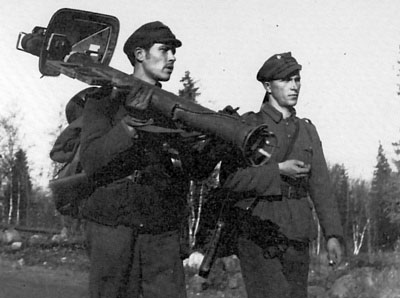 |
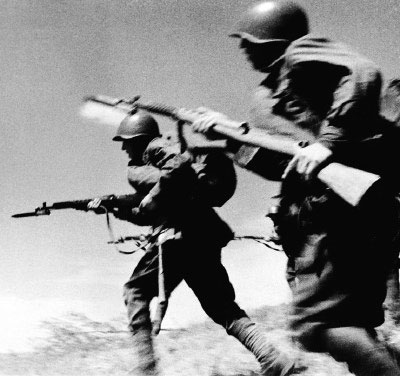 |
The battles along the third defensive line began badly for the Finns: Viipuri was captured on 20 June almost without battle. Some of the troops of the 20th Brigade, which had just arrived from East Karelia, panicked and fled from their positions. Any significant fighting took place in the city.
After the loss of Viipuri the Finnish government tried to approach the Soviet Union to inquire about conditions for peace. At this point the Soviets offensive was proceeding well and the reply was that Moscow would be ready to receive Finland’s delegation for unconditional surrender.
Stalin probably felt the Finns would soon be crushed by his troops. The Finns on the other hand knew what surrendering to the Soviets would mean. They could not accept the brutal occupation that would inevitably follow. If the requirement was unconditional surrender there was no basis for discussion. The Finns did not reply to what they saw as an ultimatum.
|
They decided to continue fighting and instead
asked Germany for help – they were going to fight for their survival
and did not have many choices. Joachim von Ribbentrop arrived in
Helsinki on 23 June to discuss their conditions for increased support.
President Ryti agreed to send a personal letter to Hitler asserting
that Finland would continue to fight against the Soviet Union and no
government nominated by him would sue for peace. The Germans gave, or
continued to give aid in the way of weapons and also brought the 122.
Infanteriedivision and the 303. Sturmgeschütz Brigade (22 StuG, 9 StuH
42) from Estonia to fight on Karelian Isthmus.
|
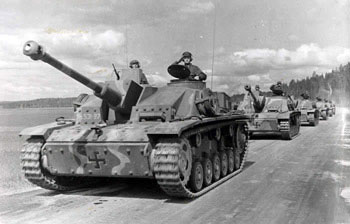 |
|
Probably the most
significant help came from Air Unit Kuhlmey (23-43 Fw-190 A6/F8, 24-30
Ju-87 D Stukas and 1-8 Bf-109 G-8 reconnaissance fighters), which
brought Finnish air power from 200 to 270 aircrafts and achieved good
results with their Ju-87 Stukas.
The STAVKA probably thought that after the fall of Viipuri Finnish Army would retreat to the Salpa line and set their next offensive target there. Soviet troops reached the Virojoki - Lappeenranta - Imatra line by 26 June, but the strong resistance after Viipuri surprised them. Between 20 – 24 June all Soviet attacks were repelled at Tienhaara and in the area north-east of Viipuri. A second wave of attacks started on 25 June and the Leningrad Front troops achieved a breakthrough in Tali, but the Finnish 4th Army Corps caused them heavy casualties while retreating towards Ihantala. The Finns made numerous counterattacks and the battles raged continuously. It was the biggest battle to occur during the entire offensive and in the whole of Nordic history.
|
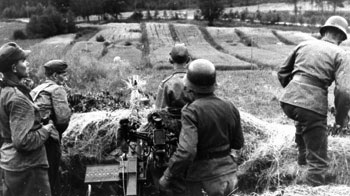 |
The Battle Of Tali-Ihantala
Early on the morning on 25 June 1944 a heavy artillery and air bombardment was conducted by the Soviets, and a major three-prong offensive against Tali began at 0730 hours. The eastern prong east of Lake Leitimojärvi was stopped by the Finnish 4th Division, but the western prong was able to breach Finnish defences at the Portinhoikka crossroads set up by 48th Jaeger Regiment with the aid of tanks from the 27th Tank Regiment. The third prong, an attack across the Saarela Strait by the Soviet 178th Rifle Division, was defeated by the Finnish 1st Battalion of 6th Jaeger Regiment.
|
Realising that this small Soviet victory could cut them off, Finns organized a massive counterattack with reserve units and pushed the Soviets west of Lake Leitimojärvi back to their starting point, destroying the 27th Tank Regiment in the process and capturing several tanks. By 27 June both sides received reinforcements and the first to move were the Finns. They set up a large combined counter-offensive using tanks and aircraft (also from Air Unit Kuhlmey), but bad communications and stubborn Soviet defence stopped it. The next day Axis troops were forced to retreat to the Vakkila-Ihantalajärvi-Kokkoselkä-Noskuanselkä Line and the Soviets, intercepting the manoeuvre, attacked them during the transition, inflicting heavy casualties and nearly routing the Finns.
|
On 2 June STAVKA ordered to 63rd Rifle Division and the 30th Tank Brigade to take Ihantala. The radio message was intercepted by Finns allowing them to stop the new offensive before it started. An aerial attack with 40 Finnish and 40 German bombers and a 250 gun artillery barrage smashed the assembling Soviet units. They were so weakened that they were not able to breakthrough the Finnish positions a few hours later. After the last failed offensive, Soviet troops continuously tested Finnish defences, but each time they were thrown back by concentrated and effective Finnish artillery bombardment. On 4 July, the Soviet 23rd Army attempted to cross Vuoksi River at Vuosalmi, which was promptly held on its small beachhead by the much smaller Finnish 2nd Division.
|
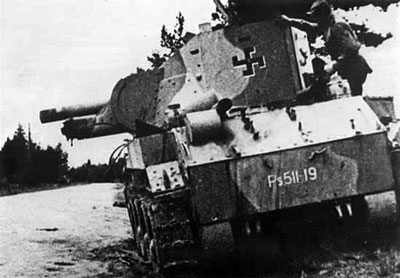 |
|
Battle In Viipuri Bay
By the time the front was in Ihantala the Soviets were exhausted and unable to start a new major offensive, although intense fighting continued. The STAVKA decided to try once more by attacking the flanks.
A beach landing was set for Viipuri Bay. The attack started on the morning of 9 July: 124th and 224th Rifle divisions, part of 59th Army, made several attempts to establish a beachhead but were always pushed back by combined Finnish and German defenders, composed by Finnish 5th Army and German 122. Infanteriedivision. At the end of the battle the 5th Army had lost 4400 men killed, wounded and missing on the islands and on mainland. The German 122. Infanteriedivision took as casualties some 600 men. Soviet losses were estimated to 12,000 killed, wounded and missing. Soviet Air Force lost some 70 planes and the Navy 70-80 vessels.
|
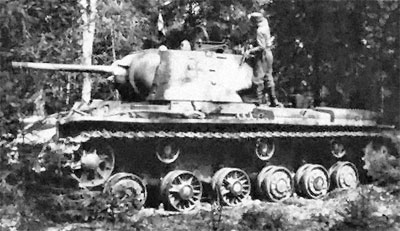 |
The End Of The Offensive
On 12 July Moscow ordered all offensives to cease in the area and began to probe Finland for possible peace terms.
The Soviets suffered about 5,000 killed and 14,000 wounded, while the Finns suffered about 1,100 killed and 6,300 wounded. The Soviets also lost several hundred tanks and aircraft during the fighting. The Soviet defeat at Tali-Ihantala was the key event that convinced Moscow to maintain the status quo on the Finnish front, and concentrate on Germany instead.
|
Last Updated On Wednesday, April 29, 2009 by Wayne at Battlefront
|
|
|